When I think of big-name guitar brands, the two names that come to mind are Fender and Gibson.
While those companies have earned their reputation by manufacturing quality guitars for decades, they’ve also earned the right to charge a fair whack for top-of-the-line instruments.
When I was a teenager and a young adult, I couldn’t afford to spend a few thousand dollars on a brand-new Gibson. For that reason, when I was at the local guitar store, I was playing Epiphone Les Pauls.
Most, if not all of us, come across Epiphone searching for affordable alternatives to the Gibson flagship models like the Les Paul, SG, and Flying V.
Top 3 - Epiphone Electric Guitars
Preview | Product | Price |
|---|---|---|
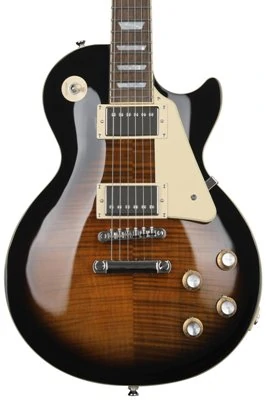 | ||
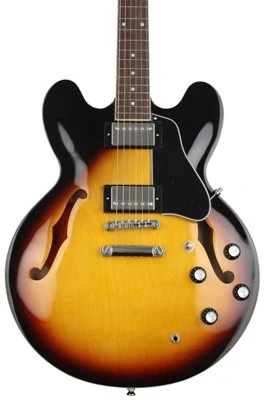 | ||
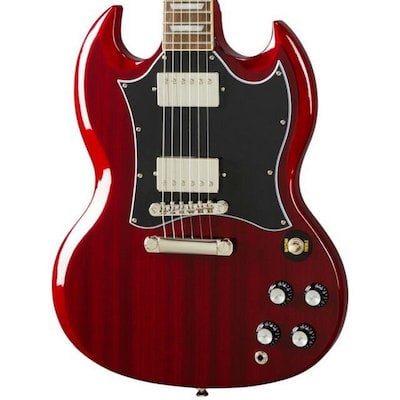 |
My students and younger guitar players are always asking me if Epiphone is a good brand? Is it worth spending (considerably less) money on a guitar that looks like a Gibson?
Well, as you probably already know, Gibson actually owns Epiphone and has done so since the mid-'50s. So how does this affect the quality and output of the company? Are their guitars comparable with Gibson’s world-renowned products?
Fortunately for you, dear reader, I’ve played more than a few Epiphones over the years. Here, I’ll take a look at a wide range of Epiphone guitars, both acoustic and electric, and learn a bit more about the company itself. Hopefully, by the end of it, you’ll have a better idea about Epiphone and whether or not an Epiphone guitar is for you!
A Brief History of Epiphone
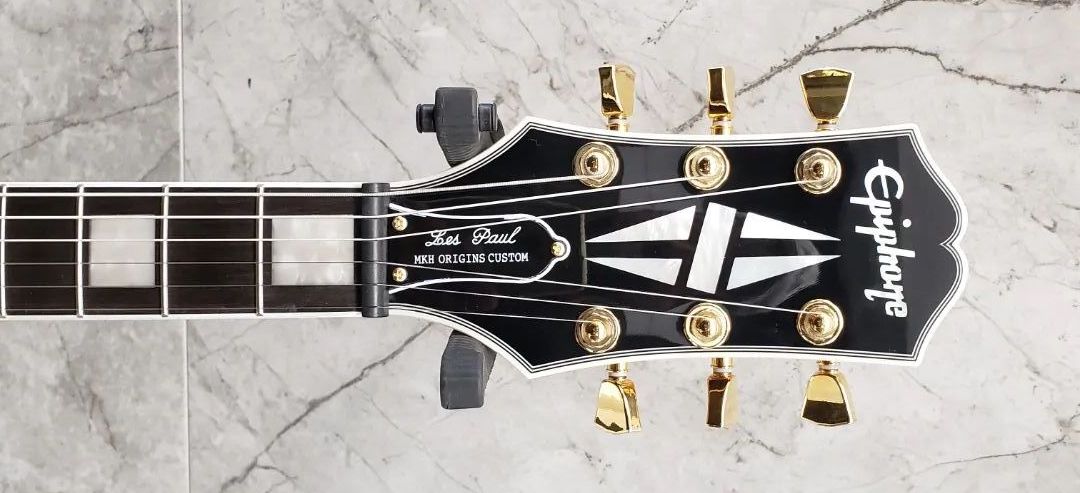
Epiphone was founded by Anastasios Stathopoulos over a century ago in 1873 as a musical instrument manufacturing business in the Ottoman Empire, now modern-day Turkey. That’s right – Epiphone is actually older than Gibson!
I actually lost a bet about this on tour many years ago: our bass player bet me the first round of drinks at the venue that Epiphone was an older company than Gibson. Fortunately for me, his taste in beer was cheaper than his taste in instruments!
In the early 1900s, the company relocated to Queens, New York City, where it underwent its first change under the leadership of its new owner – a name change. Epaminondas Stathopoulos, Anastasios’s son, chose ‘Epi’ - the first part of his first name, and ‘phone’ - Greek for ‘voice,’ or ‘sound,’ as the name, and it hasn’t changed since.
This happened in 1928, which was the year the company first started manufacturing acoustic guitars, and both arch-top and flat-top electric guitars for which it became famous. Until then, Epiphone had mainly been producing banjos and mandolins.
Fast forward to the 1930s, and Epiphone is in the midst of its rivalry with Gibson. The Epiphone Recording acoustic guitars were a moderate success, but sales suffered due to a lack of celebrity endorsement. Compared with Gibson’s L-5, which had become an industry standard since its launch in 1922, Epiphone was performing poorly.
In 1935, Epiphone introduced the Electar steel guitar series, the first guitar featuring a pickup with adjustable pole pieces. This, combined with the revealing of several new pieces including an electric piano at the NAMM show in Chicago, and a foray into amplifier production, further cemented Epiphone as a company to be reckoned with and a serious competitor to Gibson.
World War II put the dampers on the rivalry between Epiphone and Gibson and almost brought about a stop to guitar production altogether due to scarcity of materials. Then, in 1943, Epaminondas “Epi” Stathopoulo sadly died of leukemia, which changed the company for good.
The factory moved from Manhattan to Philadelphia, but many of the master craftsmen that made Epiphone what it was refused to leave New York, changing the methodology and the products that Epiphone was making.
Fast forward again to 1957, and Epiphone’s sales were practically in the gutter compared to Gibson’s game-changing Les Paul model. Ted McCarty, the then-owner of Gibson, bought Epiphone for just $20,000.
Epiphone’s production operation was relocated to Kalamazoo, Michigan, and the company, although under different leadership, was making guitars again.
Where are Epiphone Guitars Made?
Up until 1970, all Epiphones were manufactured in the USA, at the Kalamazoo plant in Michigan, alongside Gibson models. In fact, a lot of Epiphones made there in the late ‘50s and ‘60s were actually just Gibson models with an Epiphone logo on the headstock.
Many of these peak-era Epiphones graced major stages through the 1960s. I vividly remember my dad had a photo of John Lennon playing an Epiphone Casino on his wall. Even Hendrix dabbled in Epiphone guitars back then!
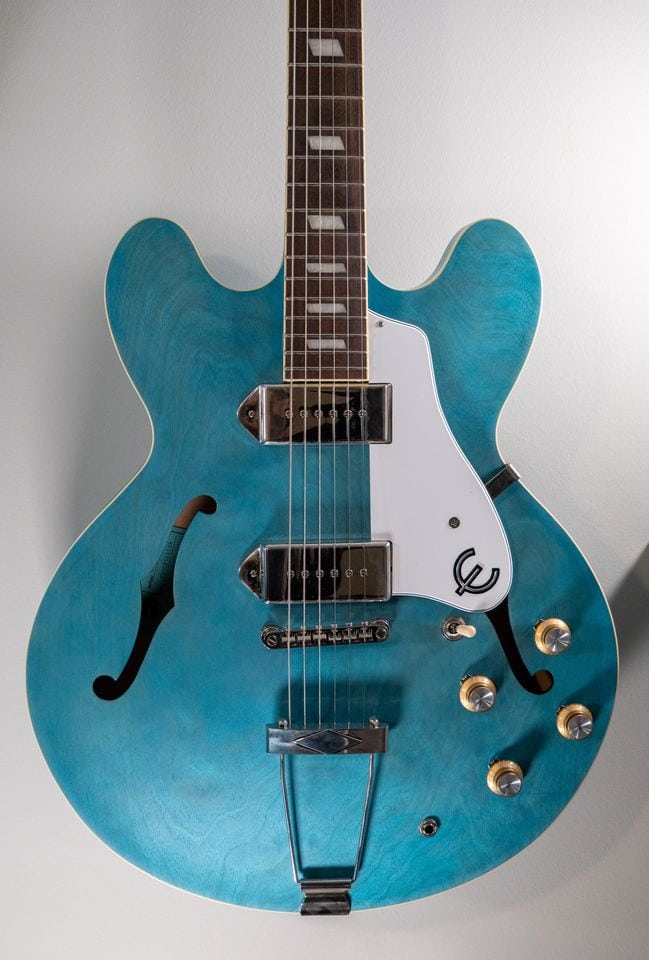
Epiphone Casino
It wasn’t until 1969, when foreign competitors started to shake up the marketplace, that everything changed. The ECL corporation purchased Gibson’s parent company CMI (and therefore also purchased Epiphone), in 1969, as Gibson was struggling to keep up with Asian-made rival models.
Epiphone production was then relocated to Japan, and it wasn’t until 1993 that any Epiphone guitars would be made in the USA again.
Nowadays, production is split between Korea, Japan, and China, with high-end models reserved for production in American factories. The bulk of Epiphone’s output is still made overseas but manufactured to much higher production standards, mainly in the Qingdao factory in China.
Are Epiphone Guitars Any Good?
So, now that the history lesson is out of the way, let’s get down to it! Of course, the answer to this question is subjective. It will depend on your personal tastes, what you want from a guitar, and the specific guitar you’re using.
To distill the question down to its most basic tenet: YES!
Epiphone guitars have always been made to a high standard, apart from a brief blip in the company’s history in the early ‘70s.
Epiphone has come a long way since then. Think about it. – if they were a serious rival to Gibson in the early days, so much so that Gibson wanted to buy them out, Epiphone was never anything to be sniffed at.
Of course, these days, they are not considered to be on par with Gibson, but that’s because the idea behind Gibson’s purchase of Epiphone was to rebrand the company as a budget-friendly version of their own guitars. Yes, as cynical as it may seem, Gibson’s plan for Epiphone was always to be a competitor with cheap foreign models.
The notion that an Epiphone guitar is inherently inferior to a Gibson guitar comes largely from Epiphone’s reputation as the main seller of budget variations on Gibson’s main line of instruments.
Is a $500 Les Paul anywhere near as nice an instrument as a $4,000 Les Paul? Not in my experience.
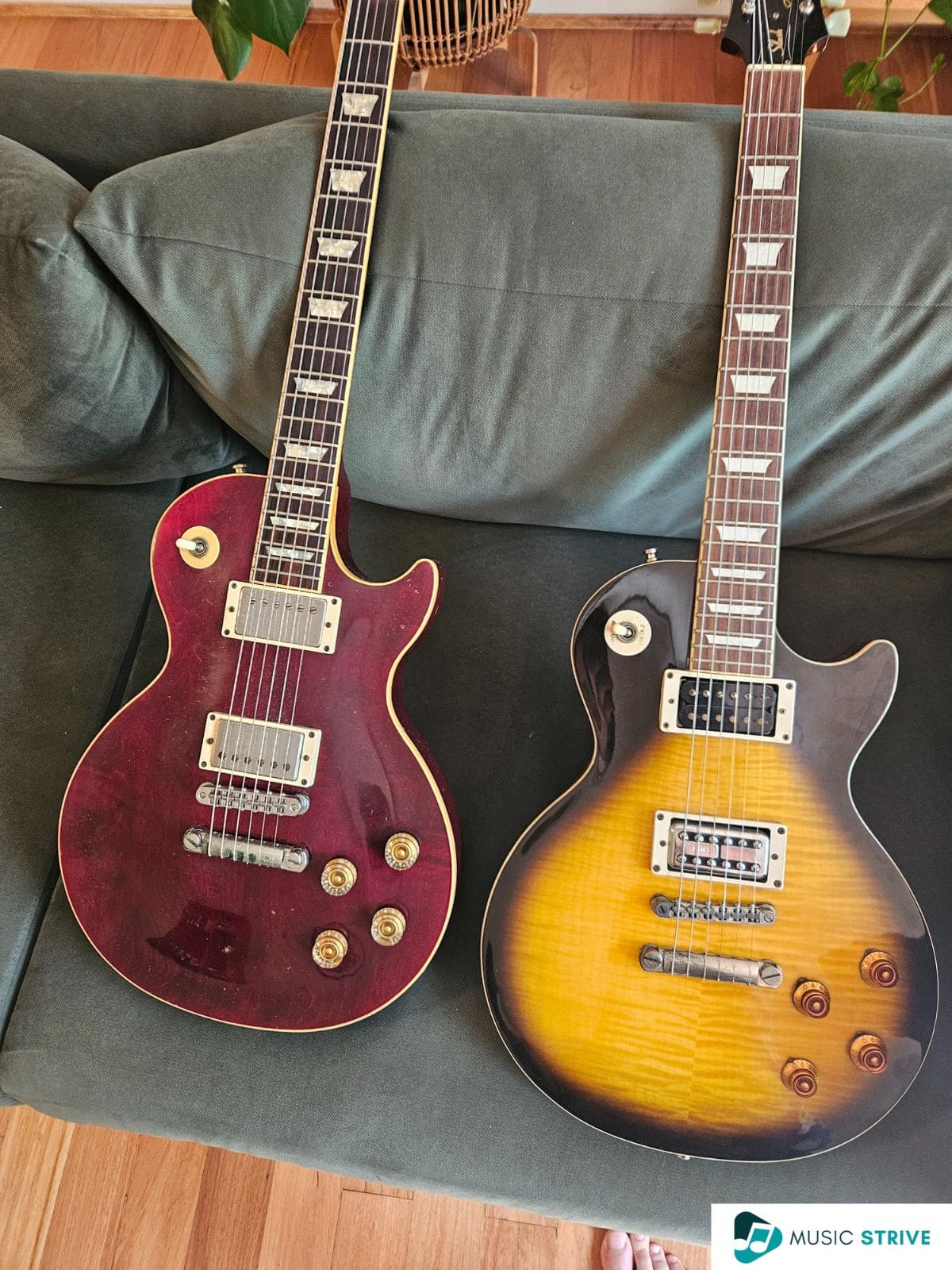
Gibson (left) and Epiphone (right) Les Paul guitars (my prized possessions!) - side by side.
Let’s have a closer look at what makes up an Epiphone guitar, so you can decide for yourself whether or not they’re good.
Epiphone Guitars – A Closer Look
If you’re anything like me, you care more than might be strictly necessary about the materials that go into a great guitar.
In this section, I’ll investigate the materials and methods used to make Epiphone guitars, look at some key models, and help you decide once and for all whether an Epiphone is the right guitar for you.
Materials – Tonewoods
Most Epiphone models are constructed from the same tonewoods that Gibson uses for their high-end guitars, albeit in different ratios and configurations.
For Epiphone’s solid-body models, mahogany is the main tonewood used, which accentuates the mid-range and offers rich low-end tones.
Maple tops are also used, which follows Gibson’s example. Maple provides brightness and clarity to the high-end, which gives both Gibsons and Epiphones a full-bodied, well-rounded sound.
I used to own a great Epiphone Les Paul Custom built exactly like this. I prefer a heavy Les Paul, and it was appreciably weighty over my shoulder. The maple top gave the guitar a nice snap to balance out the warmth of its solid mahogany body.

That's me performing with that black Epiphone Les Paul Custom.
Likewise, I’ve played the excellent “Les Paul” SG Custom which boasts an ebony fretboard as well as mahogany neck and body. That’s about as luxurious a playing experience as you can get at this price point.
The general rule for Epiphone guitars that openly replicate higher end Gibson models is that they’ll be made with similar, if not identical, woods.
In my experience, however, low-end, or budget models differ greatly from their Gibson brethren. Even on their cheapest guitar, Gibson still uses mahogany and maple. I’ve played entry-level Epiphones made of poplar, an inexpensive tonewood that, simply does not sound like solid mahogany. I particularly noticed its poor natural sustain.
However, as you can see, aside from the use of poplar on some cheaper Epiphone models, there’s not really a whole lot of difference between Epiphone and Gibson when it comes to materials.
Materials – Hardware & Finish
As you might have expected, this is where most of the differences come into play when Epiphones and Gibsons are assembled.
Pickups
Most mid to low-end Epiphones are fitted with standard, Epiphone-brand machine-wound pickups. I’m not a fan of these pickups. They’re often somehow muddier and thinner than Gibson’s USA-made pickups.
I’ve replaced the pickups in all the Epiphone guitars I’ve ever owned, usually with Seymour Duncans.
A notable exception to this rule for me is Epiphone’s newer high-end models. Signature models like the Jared James Nichols Les Paul and the Matt Heafy Les Paul Custom can come with branded pickups that vastly outperform Epiphone’s own stock humbuckers.
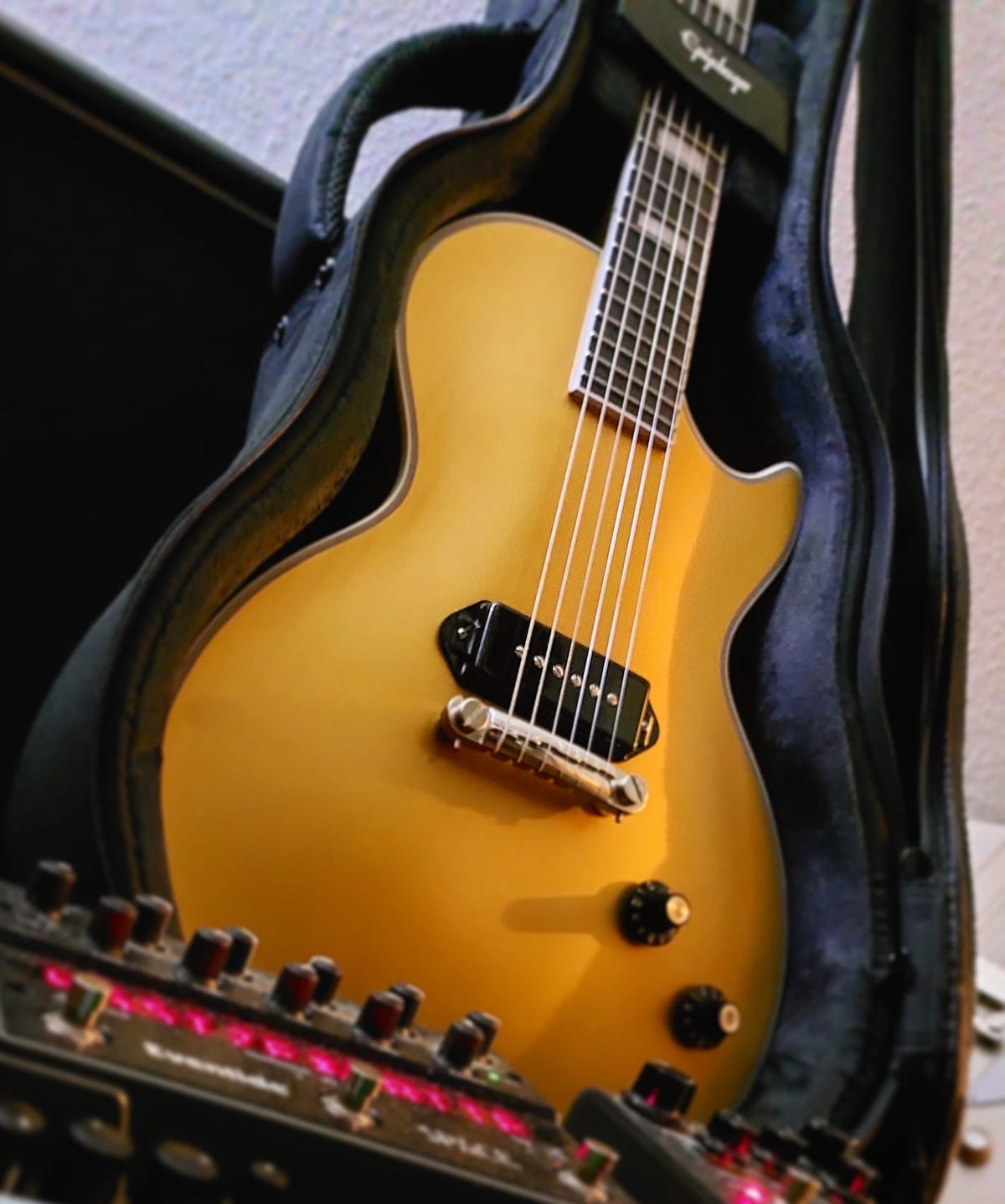
Epiphone Jared James Nichols Gold Glory Les Paul Custom (Gold Glory version)
The Fishman Fluence active humbuckers in the Heafy model in particular are responsible for the gut-punch thud of Trivium’s music and I love how they sound in dropped tuning.
Some Epiphone models, like the Limited Edition 1959 Les Paul Standard, for example, are fitted with American-made classic ‘59 style Gibson ‘burstbucker’ humbuckers.
Lacquer
As with most Gibson aficionados, to me, the classic Gibson finish is classic nitrocellulose, as traditionally used in the ‘50s and ‘60s, for that classic vintage look.
Some guitars, such as a special line of 335s, boast a satin finish. I actually like the feel and matte look of satin. It really makes guitars stand out in a lineup of glossy finishes, and the thinner finish, in theory, allows the wood of a hollowbody to breathe.
Experience tells me, however, that Gibsons almost always boast the classic nitro finish.
Many purists also believe that a nitrocellulose finish allows tonewoods to breathe, facilitating better sustain and a ‘lighter’ tone, thanks to a thinner more porous layer on the guitar body.
Every Epiphone I’ve played, however, featured a thicker, shinier polyurethane finish, which is pretty much the industry standard nowadays on mass-produced models. This even extends to Epiphone’s top-of-the-line models like the Dave Grohl 335 and the Greeny Les Paul.
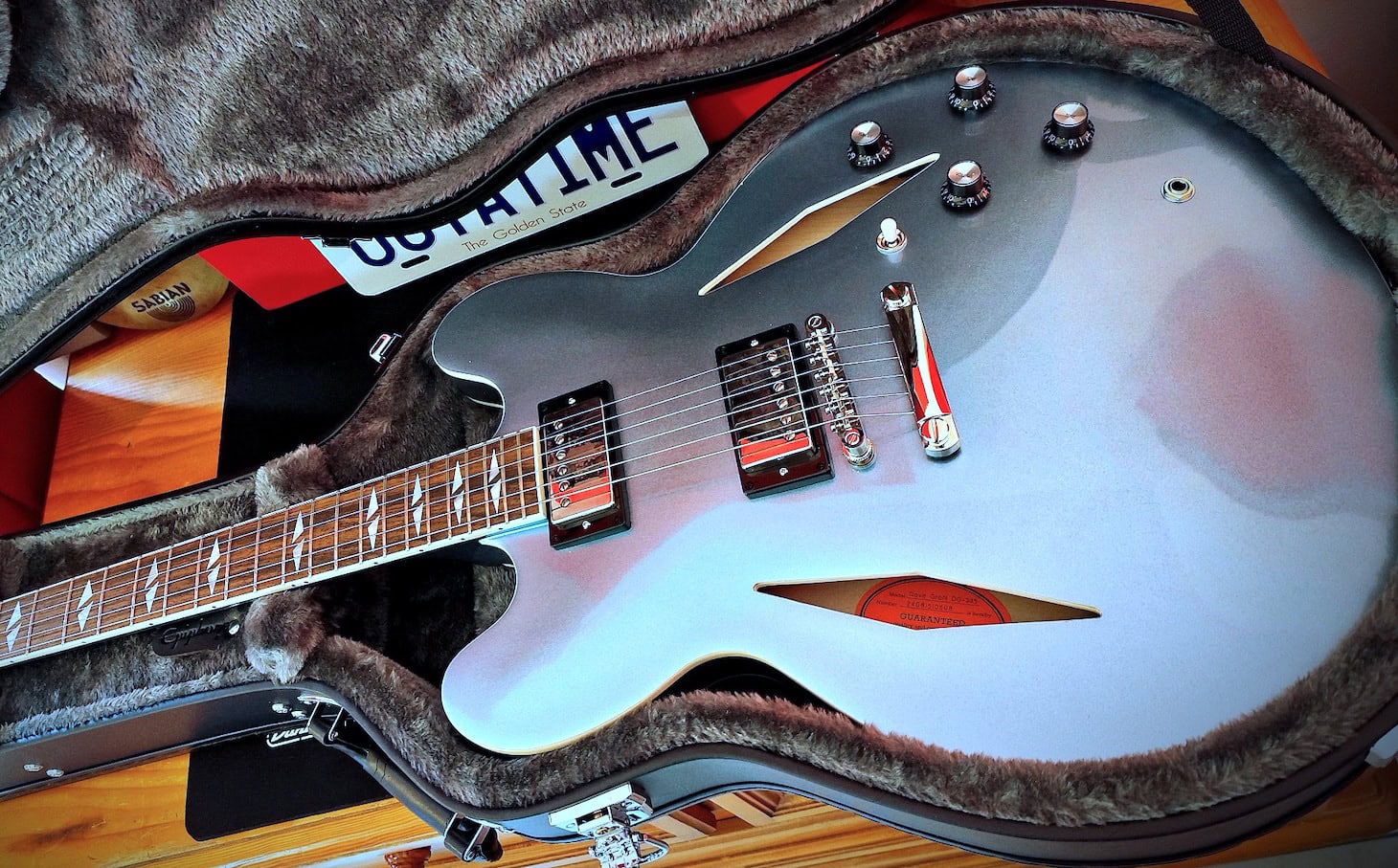
Epiphone Dave Grohl DG-335
This is mainly due to its much cheaper cost to produce and apply, and although the differences are negligible, some believe its thicker layer can dull resonance and mute the full tonal spectrum.
I’ve never noticed a difference between the two, except for how it feels against my forearm, and even that’s pretty minor.
Construction Methods
As we know, the main difference in the actual manufacturing of Epiphone guitars compared to Gibsons is the location. Whereas Gibsons are produced in America, the vast majority of Epiphone models are produced overseas in Asia – Korea, Japan, and China, to be precise.
Epiphones are produced using more mass-production methods – think production lines with automated machinery as opposed to human care and attention applied to every single guitar.
Though there are stages of the process that can only be done by a human hand, these are usually just finishing touches, and workers will still have to perform these tasks on hundreds of guitars a day.
As a rule, Gibson guitars feature set necks, while entry-level Epiphones like the SG Special have bolt-on necks as a cost-saving measure. I like the classic set neck of a Les Paul Standard: bolt-ons are for Fender guitars!
Popular Epiphone Models – Electric
Now let’s take a look at some of my favorite Epiphone electric guitars, to help you get a better idea of exactly what you get for your money when you buy from Epiphone!
Casino
Let’s start with one of Epiphone’s most popular and enduring models: The Casino. It has been featured on more hit records than any other Epiphone guitar, and was famously used by every member of The Beatles – except Ringo!
To me, the Epiphone Casino is the Epiphone guitar.
I love the Casino’s warm vintage tone and easy playability. I’m particularly fond of its P90 pickups, which offer a sharper edge than the humbuckers. The Casino has become a mainstay of pop and rock groups over the years – despite its notorious feedback issues.The ear-splitting feedback of '90s-era Oasis concerts can largely be blamed on this single-coil-equipped hollowbody!
As with most Epiphone guitars, you can find a Chinese-made Casino pretty cheap, but if you’re looking to splash out, Epiphone have started producing a line of USA Casinos, with expectedly different build quality.
It’s the same guitar, just a little nicer: the C-shape neck is slightly more comfortable, the pickups sound clearer and warmer, and the overall build quality of the USA-made Casino more sturdy.
However, it’s worth noting that both models feature the same Epiphone P-90 pickups, neck shape, and fret joint. The only thing different is the construction methods – everything on the USA-made model was done by hand.
Les Paul
Of course, the Les Paul is synonymous with Gibson, but Epiphone also offers their own (much cheaper!) version of this iconic silhouette.
My first nice guitar was a 2008 Slash signature Epiphone Les Paul with Seymour Duncan Alnico II pickups.
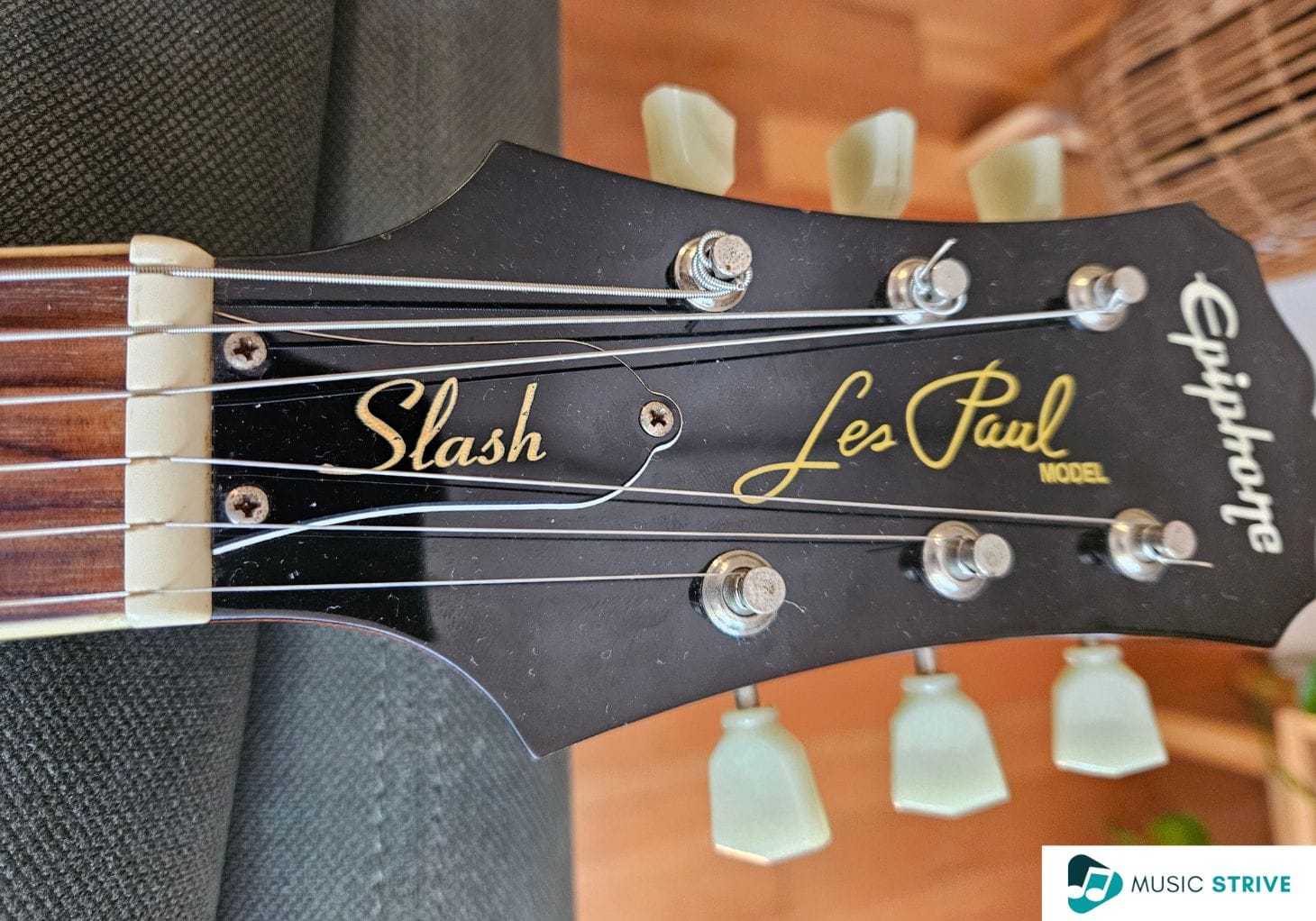
Headstock of my Epiphone Slash Les Paul - it features Grover tuners.
It played, looked, and sounded better than all my friends’ guitars. I worked for months tossing fries and flipping burgers at McDonald’s to save up for it, and I still own and play it to this day.
The Epiphone Les Paul Standard features a solid mahogany body with a thin maple top, closer to a veneer, differing from the Gibson version, where the maple top is carved.

Epiphone Les Paul Standard
I’ve played Epiphones with various weight relief measures clearly aimed at the student market. My Slash model, for example, has a lightweight chambered mahogany body.
A standard Les Paul has 22 frets and the classic Alnico humbucker pickups – all notable features of the classic Gibson Les Paul.
I’ve always loved the Les Paul’s classic parallelogram fret inlays as opposed to the dots you often see on cheaper guitars. It’s something that requires that little bit of extra craftsmanship, so you know more care has gone into this guitar than you might have thought for a made-in-China budget model.
On my Epiphone Les Pauls, the action is low, the sound quality is high – another Epiphone bargain!
I tend to use Les Pauls for everything. Heavy metal, rock, even pop and country playing. My Epiphone Les Pauls sound great pretty much everywhere from clean country twang to full-bore metal distortion.
SG
The Gibson SG is an icon. The unique shape, the countless famous players such as Angus Young and Frank Zappa, and of course, the legendary clear, sharp tone.
Well, the Epiphone SG Custom and Standard have a different name on the headstock, but can they live up to the status of their predecessors?
I love the look of the SG Custom. The gold hardware and the bound neck are eye-catching and classy, as well as the pearly inlays (even if they are just plastic). It’s the Vegas Elvis of Gibson SGs.
While I prefer a heftier guitar, I appreciate the Gibson SG’s low action and fast neck – something that the Epiphone factory in China seems to be struggling to replicate. I’ve played a few cheaper SGs with looser almost malleable bolt-on neck joints. They had higher action, and didn’t play nearly as easily as my friend’s mid-70s SG Standard.
Of course, as with my issues with stock pickups, there are simple fixes. A professional setup by a luthier, or doing it yourself by tweaking the truss rod, makes a world of difference.
Likewise, the issue is nonexistent on well-made set necks. Perhaps this not being ready out-of-the-box is a sign of the inexpensive construction costs. I avoid this issue most of the time: I always try the guitar out at the store! Perhaps this not being ready out-of-the-box is a sign of the inexpensive construction costs.
Sound quality, however, is not an issue. The Alnico pickups sound great, especially when played hot. Clean tones suffer a little, but it’s nothing a bit of fiddling with the tone controls or substitution for a set of superior aftermarket pickups can’t remedy.
If you're on an even tighter budget, you can grab this SG Special from Amazon for less than half the money of the more premium Epiphone siblings.
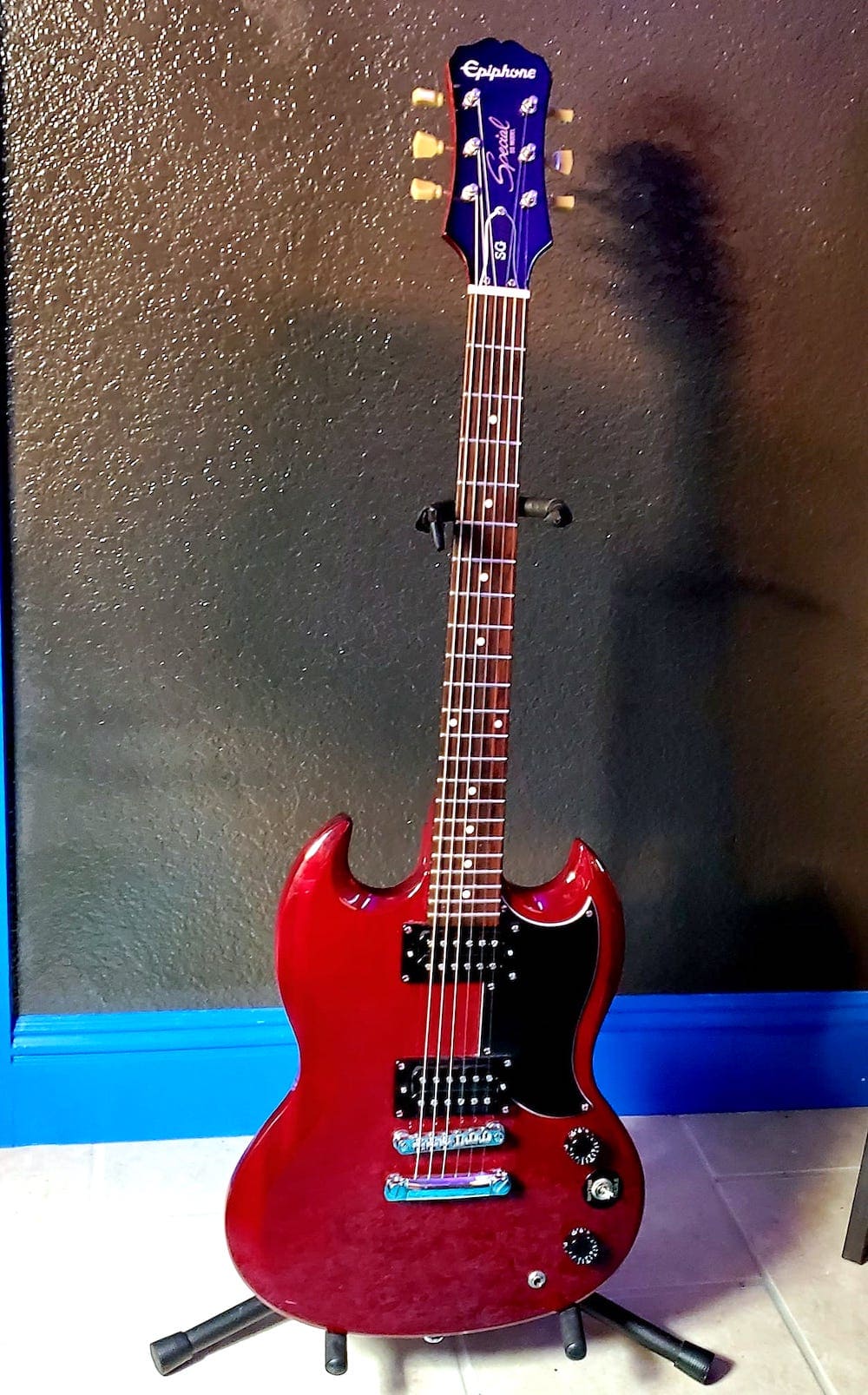
Epiphone SG Special
Sheraton
The Epiphone Sheraton is one of many guitars modeled on the famous Gibson ES-335. I recently learned that the original Sheraton was built using spare 335 bodies from the Gibson factory! This semi-hollowbody guitar has become a favorite for both blues and rock players over the years, largely due to the Sheraton’s incredible sound and versatility.
To me, the Sheraton will always be the Oasis guitar. Noel Gallagher wielded a few Epiphone hollowbodies in the '90s, including the Riviera, and the iconic model emblazoned with a Union Jack.
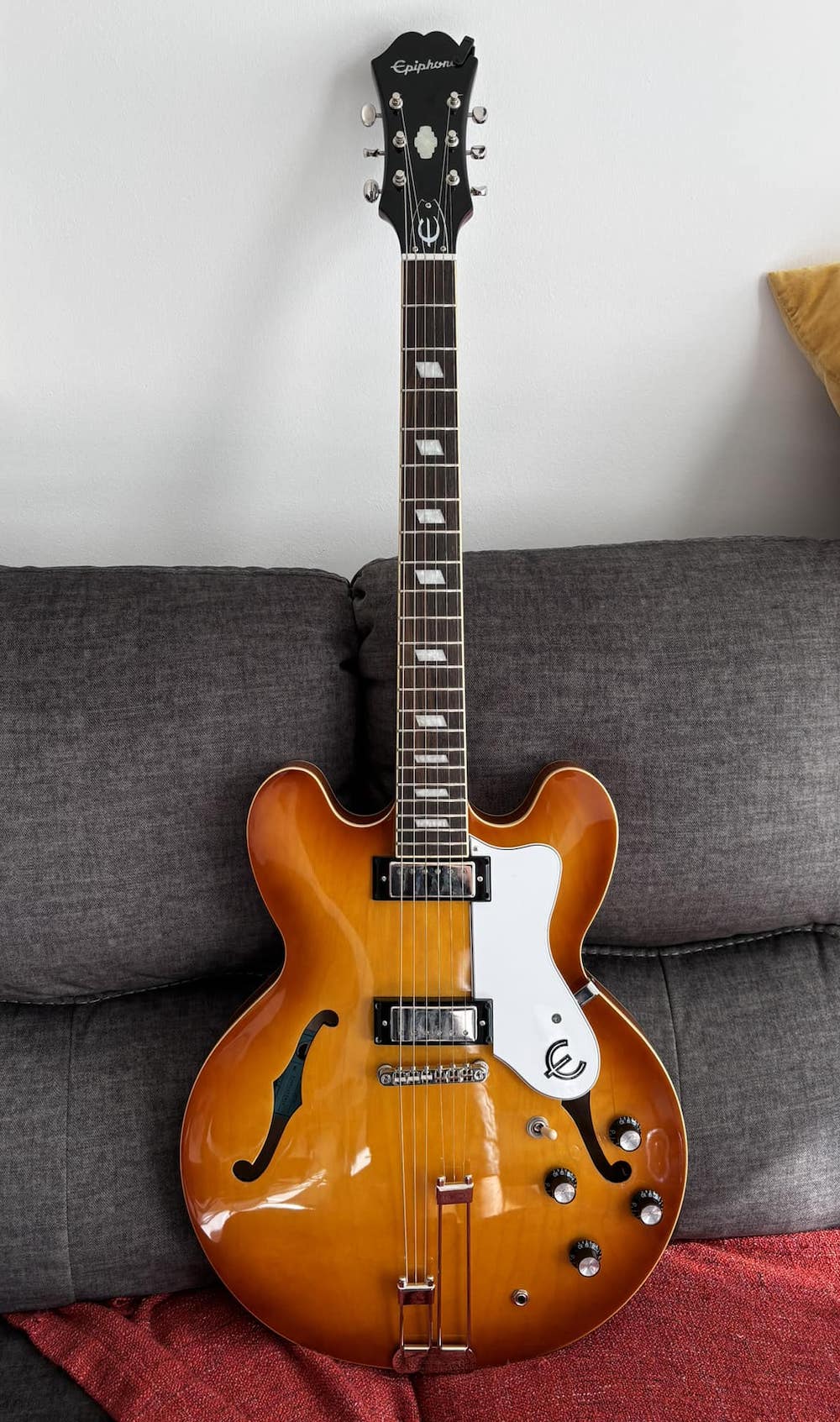
Epiphone Riviera
There have been a few Sheraton models over the years. I recently tried out the modern iteration, with mini humbuckers and a vintage-style Frequensator tailpiece. Personally, I prefer the full-size humbuckers and tune-o-matic bridge on a 335, but it’s a nice guitar.
The main thing I liked about it was its mini humbuckers, which offer a brighter tone than my 335’s full-size humbuckers.
I’d be as inclined to use this Sheraton for rapid, twangy country chicken pickin’ as I would for big, distorted Oasis chords.
For a fraction of the price of a Gibson 335, the sound and build quality are beyond reproach. The Sheraton boasts incredible volume, resisting feedback fairly well thanks to the 335-style center block.
The range and variety of tone that I’m able to achieve just by tweaking the control knobs is astounding, and the clarity and resonance that this all-maple guitar can produce is comparable to my 335.
The only negligible downside is the weight of the Sheraton. Considering it’s a semi-hollowbody, it sits quite heavy on the shoulders, perhaps due to the quality of the wood used in its construction. It’s not as heavy as a Les Paul, but nowhere near as light as a Casino.
Overall, the Sheraton is a class-act, and one of the best guitars available in this price bracket.
Popular Epiphone Models – Acoustic
Epiphone also produces a range of acoustic guitars, many of them based on classic Gibsons like their electric lines. Let’s take a closer look at some of my favorites among the best-sellers and list-toppers.
Hummingbird
The Epiphone Hummingbird is directly inspired by Gibson’s own model of the same name, a square-shouldered dreadnought that found its way into the hands of Keith Richards and Sheryl Crow alike.
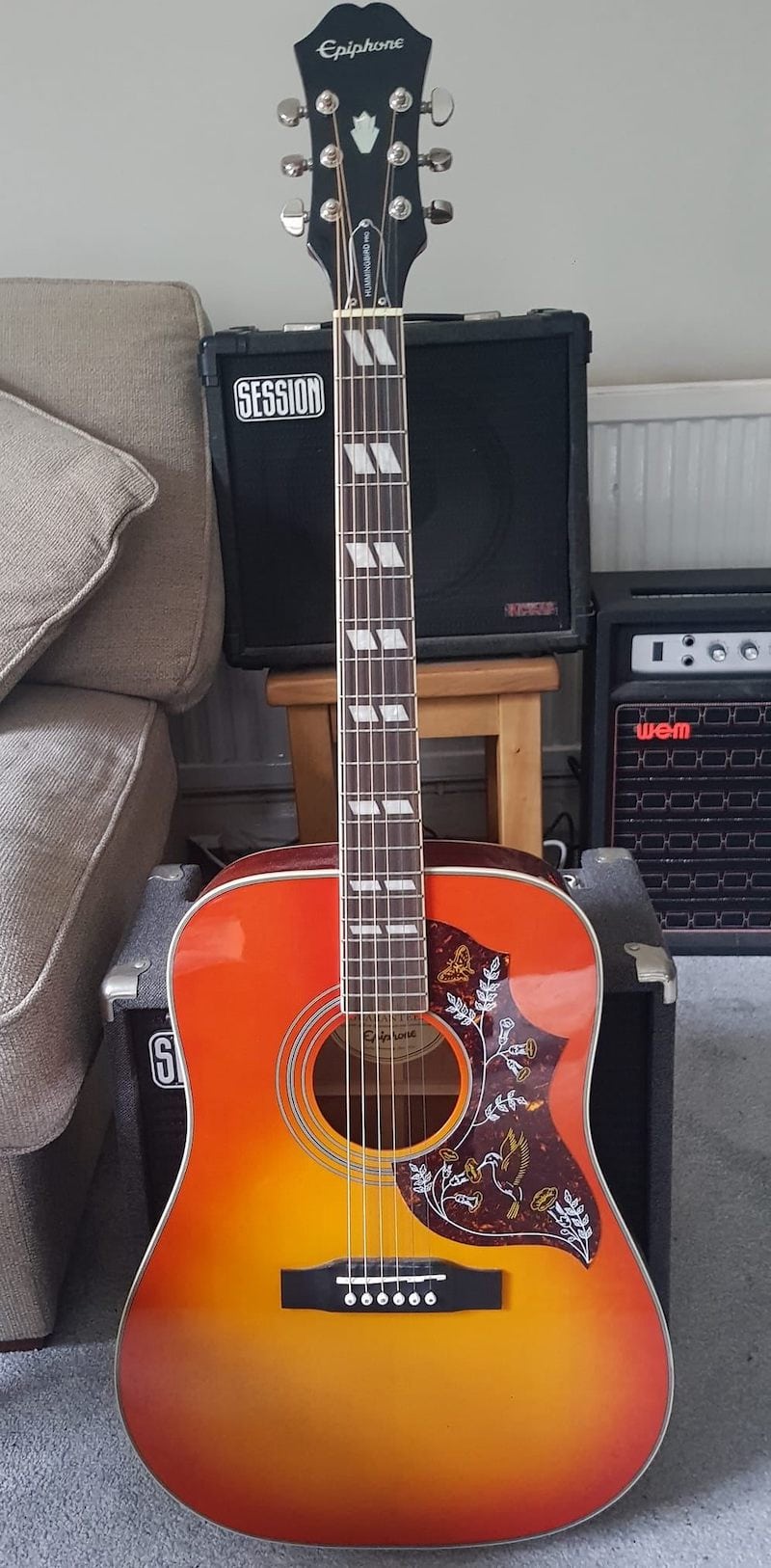
Epiphone Hummingbird
I played an Epiphone Hummingbird at a recent studio session, and I loved the sound of it especially in my favorite acoustic tuning of Drop D.
The solid Sitka spruce top gives the Hummingbird an incredible resonance, especially on the low end, and its ornate design and extravagant detailing have made it a firm favorite for strummers and finger pickers everywhere. I could feel the guitar resonating against my body as I was playing!
There’s not much difference between the Gibson original and this Epiphone budget version. The nut width is slightly narrower on the Epiphone, but only by a fraction of an inch (1.69 vs 1.72 on the Gibson), and the fretboard is Indian laurel as opposed to rosewood.
As far as playing experience goes, it doesn’t feel much different at all.
The finish is polyurethane instead of nitrocellulose too, but these are minor differences that only the most discerning pro would really have issues with. I prefer the feel of nitro under my forearm on an acoustic guitar, but it’s a really minor issue.
J-45 Studio
When it comes to super-affordable acoustic guitars, you can’t go wrong with the Epiphone J-45 Studio.
The J-45s I’ve played are all classic American acoustic guitar construction: mahogany with a solid Sitka spruce top, so the quality of the wood translates directly into sound quality.
Plenty of sustain and warmth, with a little sparkle on the top end. If you’ve heard an acoustic guitar on a popular record of the past 70 years, you’ll recognize the tone.
Every J-45 I’ve played had a nice low action, no fret buzz, and held its tuning well. For a basic acoustic guitar, the sound profile is impressive, boasting a solid, but not booming, low end, balanced mids, and bright highs.
This is a great all-rounder built with great attention to detail, and a superb warm tonal quality.
DR-100
The Epiphone DR-100 is a dreadnought of considerable size and power, and at such a competitive price it makes an ideal beginner guitar, though maybe not for children or those with a small reach.
Fortunately for me, I’m a little over six feet tall and not exactly built like a featherweight boxer: the dreadnought is a really fun guitar for me to play.
Epiphone clearly agrees with me about guitar construction: if it ain’t broke, don’t fix it. The back and sides are mahogany, while the top is spruce. The major difference between the DR-100 and most other acoustic guitars on this list is a big one: the DR-100 is constructed of laminate woods.
This lowers the production cost considerably, which is why you’re able to find a DR-100 for so cheap. This does impact sound quality however, and the DR-100 can fall a bit short when it comes to resonance and projection. I’ve found it nowhere near as resonant and balanced as a solid-topped acoustic guitar, and the tone decays far too quickly for my liking. Likewise, it doesn’t react as well to differences in playing dynamics as the J-45.
Having said that, the guitar is well balanced across the tonal spectrum, with rounded, full-sounding low-end and bright highs.
Masterbilt Texan Acoustic-Electric
The Epiphone Texan is a classic acoustic. I’ll always think of Paul McCartney and Noel Gallagher as archetypal Texan players. To me, it’s the “Yesterday” guitar.
The classic Texan has been reimagined for the modern day as the Epiphone Masterbilt Texan.
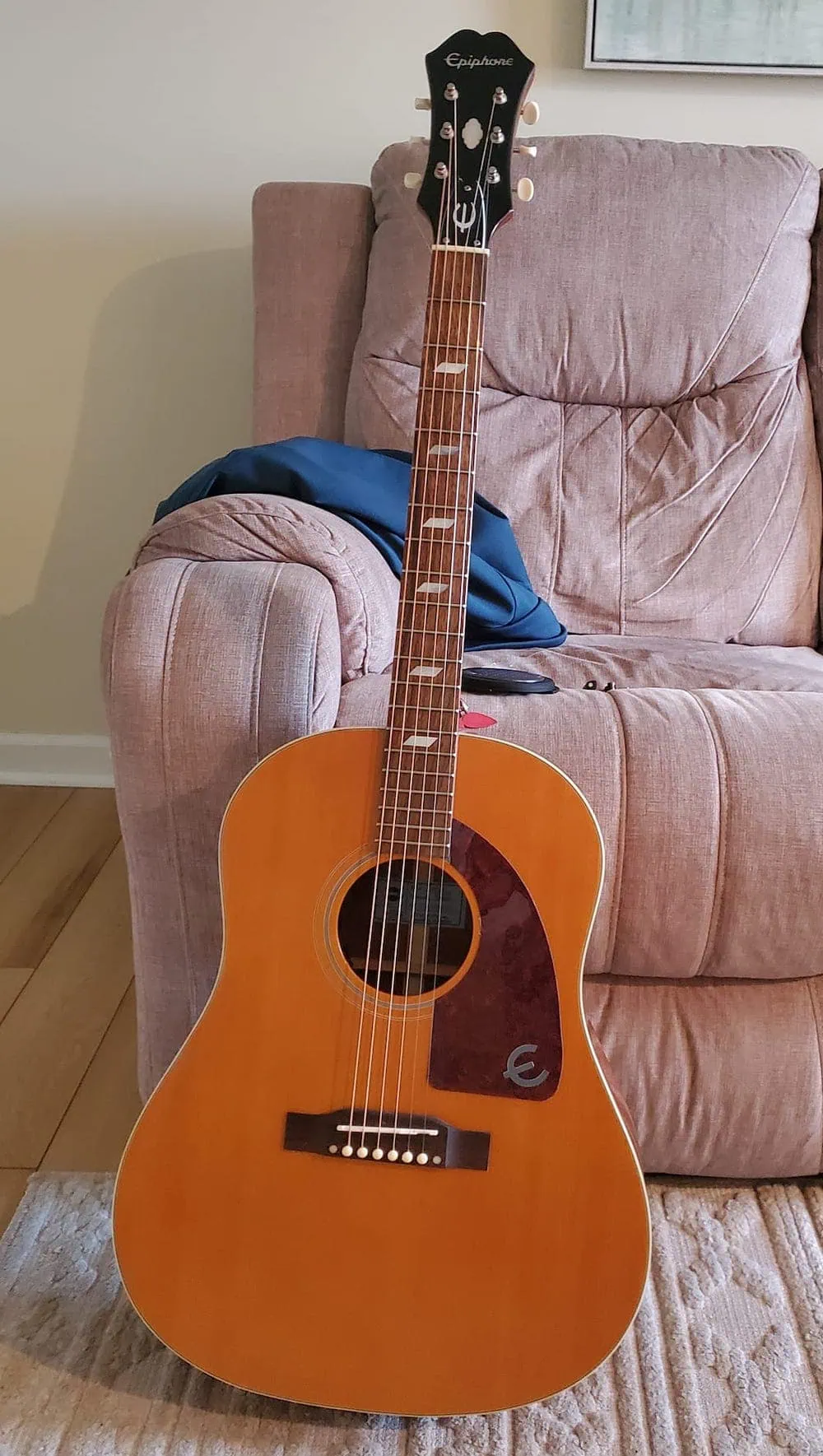
Epiphone Masterbilt Texan
The modern Epiphone Texan is now acoustic-electric and features Fishman Sonitone electronics so I was able to take it to a gig and plug in to play. The controls are neatly tucked into the soundhole; I found them easily accessible without altering the classic country look of the guitar.
I prefer the on-shoulder controls of, say, my Takamine New Yorker, but for the sake of the guitar’s iconic looks, I understand the choice.
The Texan is a great-sounding guitar. While the name and its appearance inspire bouts of hybrid picking and bluegrass licks, it’s also great for strumming. It’s hard not to enjoy the deep, throaty sound of its wound strings.
Considering this guitar is produced on a production line, the build quality is very impressive, with no sharp frets or signs of complacency regarding quality control. It makes for a really comfortable playing experience.
Epiphone’s classic acoustic tonewood pairing of solid mahogany back and sides and a solid spruce top give the Texan a bold tone that projects well and practically shimmers in the high-end.
Final Thoughts
The question, ‘Are Epiphone guitars good?’ is a tricky one to answer, mainly because every guitar is different. Overall, I think it’s safe to say that yes, Epiphone definitely makes some very good guitars, for a very reasonable price.
I’ve been playing various Epiphone guitars for over fifteen years, and I love them just as much today as I did as a teenager.
There are always going to be certain touches lacking from a mass-produced product compared to one hand-made in the USA, but if you can look past that, you can get your hands on something very close to a Gibson, often for less than half the price!


I’m 66 yes old owned alot of guitars I just got a epiphone les Paul Jr 1957 reissue it’s TV yellow sounds awesome with a p90 I have a SG Jr epiphone it says limited edition custom shop I love both but the less Paul’s made in Korea says handmade you can tell by playing it Its my favorite all time guitar
I Paul own 3 Epiphone guitars all of them are great love them. I have owned Gibson guitars and they are also great. I just wanted to throw in my favorite guitar a more than 40 year old Cortez Stat copy that all the hardware has been changed it is a great guitar.
Sure they’re good. I’ve played a few Epiphone Les Pauls that would easily stand up to Gibsons!
Japanese and USA casinos use Gibson p90s not epi. Construct is very different as you would expect. Gibsons use bigger wood pieces and better cuts as you would expect. I use to really like Korean Epiphones but early Chinese ones sucked. They are better now but I try to try to avoid Chinese as much as possible. That said the 1959 Les Paul with Gibson pickups is supposed to be a good one.
I like my Epiphone guitars I don’t need a Gibson.
Gibson and fenders are mostly CNC machines that do most of the construction, as im sure your aware, labor is mainly the higher cost, the fine detail is in the fret work, finish etc. and sense all wood differs, non are the same, and do to computer machines, the days of the hand work such as band saws etc are no more
I had a Epiphone SG standard lefty (90s). It was, sorry to say, a POS. The construction, tone, feel, I almost gave it away, just to get shed of it. Later I got a Gibson SG, Special, Tribute, noiseless P-90s, (lefty) that was a better by far, in every respect, honestly, no comparison. I also had a 61 SG Special, 3 pickups, lefty. One it fell off the stand, snapped the neck in two.
Yes, I think I lost consciousness at that point!
Love my Epiphone alpine white les paul custom! Plays like a dream! Beautiful guitar! I used to own a Gibson custom shop les paul, this Epiphone plays just as well at a much better price!
I have owned a gibson sg, a les paul, and a melody maker, and they are not worth the price they now want. I bought a fender mustang in the late ’60s and was not happy, so I tried a Gretsch Tennessean and it sounded great threw my fender super amp, but didn’t stay in tune, so I went to a fender telecaster loved it,I had a red epiphone casino, and it was okay, but two years ago I bought a epiphone es335 pro and I love everything about it but the three way switch could be upgraded, but otherwise it is my favorite along with my tele.
Gibson, Taylor, Martin…great, if you can afford them. For a third of the price (or less) you can purchase a great looking, great playing Epiphone. I own several acoustics and I love them all!
Couldn’t agree more. I’m an avid fan of Epiphone too. I think they’re incorrectly placed in the same bracket as Squier. They’re much much better quality instruments in general!
Excellent piece! Been picking since 1960s HS kid. As with Fender, the Gibson bean-counters took over, moved the factories and let the craftsman walk.
Never thought I would own a LP until I bought my pawnshop LP100 for $80. Like my friend Sandra’s Japanese Epi classical she has a headstock-back sticker which reads, “Imported and professionally set up by Epihone U.S.A.”
Like my Indy-Squier Strat, I proudly show my headstock to show the world a BETTER guitar (with excellent music) AND that I’m intelligent enough NOT to pay 3X as much for a headstock logo.
I have read several accounts of Epiphone but none more comprehensive than this one. Thanks again.
I have been playing guitar for 62 years. I have had both Epiphone and Gibson. For my money Gibson every time.
Can you elaborate on that?